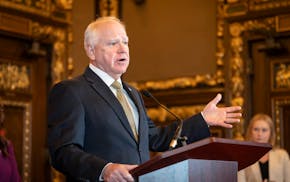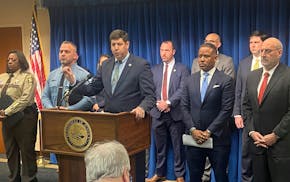Dozens of Twin Cities-area school districts are planning steep budget cuts and teacher layoffs for next school year.
The 47 districts in the Association of Metropolitan School Districts (AMSD) face a combined budget shortfall of more than $280 million, according to a survey the group sent out to its member districts. Those districts collectively enroll more than half of Minnesota's public school students.
"Unfortunately, this isn't new," said Scott Croonquist, executive director of the association. "But I do definitely hear the feedback that it's a little more urgent this year."
In some cases, that's because districts already drew down reserves to fill budget gaps for the current school year, but the budget challenges of the past few years haven't gone away. Plus, there's new uncertainty about the future of federal education funding.
Most districts won't finalize next school year's budget until June. But the proposed cuts are being outlined now. Here's what you need to know.
Why are some teachers getting layoff notices?
School districts are crafting budgets amid uncertainty about state and federal funding, and those facing shortfalls must propose reductions to balance their spending plans.
In Minnesota, around 80% of districts' budgets go toward personnel costs. Many districts, including the state's largest, Anoka-Hennepin, have already dipped into cash reserves or reduced their administrative departments to try to minimize the number of teacher layoffs.
"Districts always try to avoid cuts that impact the classroom, but there's only so much of that they can do," Croonquist said.
In some cases, staff who receive layoff notices can be called back or find other positions in the district before the next school year starts.
What is driving the cuts?
Most of the factors are the same across school districts:
- Flat or declining enrollment. Since state funding is doled out on a per pupil basis, dips in student numbers mean less revenue for a district.
- The end of one-time pandemic relief funds. Millions in federal relief dollars, which helped many districts balance their budgets, ended in September.
- Inflation and higher operational costs.
- Escalating labor costs. Last year, Minnesota teachers saw their biggest wage increases in 20 years, according to Education Minnesota, the state teachers union.
Some districts have additional reasons for their proposed cuts.
Robbinsdale Area Schools realized last fall that it would need to slash $21 million — 10% of its budget — largely because of a budgeting error.
The district recently laid out some of the staffing reductions in a letter to families announcing that more than 180 positions will be affected.
"It's important to understand that not all of these are the result of budget reductions — many reflect routine, annual staffing changes due to enrollment changes, licensure, program shifts, or non-renewals unrelated to budget," Superintendent Teri Staloch said in the letter.
"That said, we estimate a $13–$15 million reduction in school-based staffing. These reductions are incredibly difficult — and they are not made lightly."
What about state funding?
The DFL-controlled Legislature approved a sweeping education bill in 2023 that gave schools more than $2 billion for new spending, but much of the money was earmarked for specific programs, including free school meals.
This year, school districts are assuming a 2.74% boost in the education funding formula to account for inflation — an increase that Education Commissioner Willie Jett recently announced.
But districts say that's not enough. The projected budget shortfalls included in the Association of Metropolitan School Districts survey were based on projections that included the 2.74% increase.
And federal funding?
Minnesota receives about 10%, or $1.4 billion, of its school funding from the federal government.
Last month, President Donald Trump signed an executive order that would partly dismantle the U.S. Department of Education, creating uncertainty about potential cuts in federal funding and how they would affect Minnesota schools.
What's next?
Districts will continue to work toward finalized budgets and adjust, if needed, after the legislative session ends and the state's biennial budget is done.
After a presentation of the proposed budget for Anoka-Hennepin schools, Superintendent Cory McIntyre reminded the school board that finance staff will continue to watch for state-level changes that would affect district budgets.
"I just want to reiterate that the budget is based on what we know today," he said. "We are waiting to see where it really lands in the end."

Accomplished climber, photographer who recently moved from St. Paul missing on mountain

Walz: State had no advance notice of federal raid in Minneapolis

DOGE cuts federal money for upgrades at Velveeta plant in New Ulm

Five members of Minneapolis Highs street gang found guilty of racketeering conspiracy

